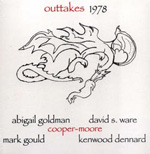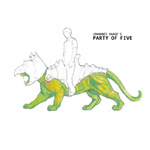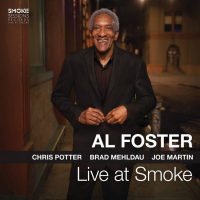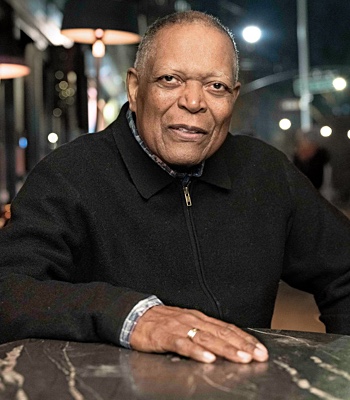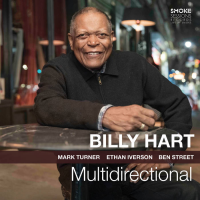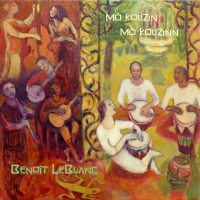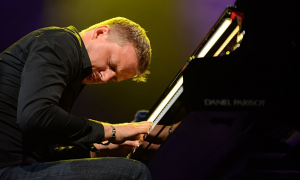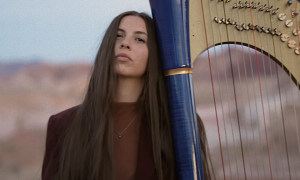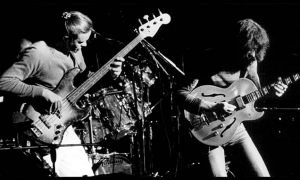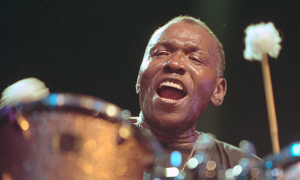Home » Jazz Articles » Interview » Bobo Stenson: Faithful Yet Irreverent
Bobo Stenson: Faithful Yet Irreverent
You want to be faithful, but then you try to take the vibe of the context of the piece, go on with it a little more, and take it a little further.
Along with Stanko and Rava, Swedish pianist Bobo Stenson is another artist long-associated with ECM whose profile has risen in recent years. Through his work with Stanko, saxophonist Charles Lloyd and his own trio, his delicately nuanced approach to interpretation is finally getting the attention it deserves. He may not have the cachet of a Keith Jarrett, but on his latest release, Goodbye—featuring long-time musical companion, bassist Anders Jormin and drummer Paul Motian—he demonstrates an equal improvisational élan; the ability to both get to the musical heart of things and take it to new and unexpected places.
Formative Years
Stenson's formative years weren't particularly extraordinary, although he did have the advantage of growing up in an environment filled with music. "I grew up in a musical family," says Stenson, "where everybody was playing—my brother, who was six years older than me, played drums. I started with classical piano at the age of seven, but got into jazz at twelve, probably because my brother brought jazz into the house. I used to play along with his record player, with people like Bud Powell, Miles Davis and George Shearing. But then I got more specialized. I grew up with Miles Davis and Bill Evans, also Wynton Kelly, Red Garland and Bobby Timmons. I got into John Coltrane quite early; he ultimately became my big hero through the years."The emigration of American artists to Europe in the '50s and '60s meant that young musicians like Stenson had an opportunity to gain early exposure and experience. "A lot of Americans came through," Stenson explains. "so I got to play with people like Don Cherry—he lived in Sweden for quite some time, and I got to know him. That was in the early 70s. I played with Dexter Gordon in the 60s. Because a lot of people came to Copenhagen to live, they also went to play in Sweden. And then others came via Norway, people like George Russell, who I got to work with quite a lot later on."
The ECM Connection
While not necessarily the best gig that Stenson had, a chance to work with saxophonist Stan Getz may well have proved to be the most auspicious. "I was playing with Stan Getz around 1970 with [drummer] Jon Christensen and [bassist] Arild Andersen," says Stenson. "I'd met Christensen a little before that, but with Getz we got to know each other well and after that I spent a lot of time in Norway, which was a very creative place at the time—and, of course, continues to be. Meanwhile, Manfred [Eicher, owner of ECM Records] had been introduced to [saxophonist] Jan Garbarek and also knew Arild, Jon and [guitarist] Terje Rypdal. He wanted to record us and it went from there."I did an album with Terje, Terje Rypdal (ECM, 1971), SART (ECM, 1971) with Garbarek, Terje, Arild and Jon, and then my own record, Underwear (ECM, 1971), with Arild and Jon," Stenson continues. "In the beginning we were like a little family. Then around 1973 I was supposed to do another trio record. I was at a festival in Warsaw with Don Cherry, and Jan, Jon and [bassist] Palle Danielsson were also there. We went to a jam session one night and it just took off for us—people are still talking about that jam session, it was something else. And so we ended up forming the Garbarek-Stenson Quartet, and since I was supposed to be making a trio record, I said, 'let's do it as a quartet instead.'"
The resonance of Witchi-Tai-To (ECM, 1974) and Dansere (ECM, 1976) cannot be underestimated. Both albums introduced the players to North American audiences—aided, in no small part, by the fact that Garbarek, Danielsson and Christensen were also playing in Keith Jarrett's newly-formed European Quartet that released Belonging on ECM the same year as Witchi-Tai-To. If anything, hearing the same trio with two different pianists merely highlights the differences between Jarrett and Stenson. Jarrett is clearly the more overtly virtuosic of the two, but he's also a more dominant personality—something that has its pros and cons. Stenson's stronger ensemble emphasis meant that, despite Jarrett's group being clearly about collaboration, the Garbarek-Stenson Quartet felt more like a group of equals, rather than a weighted group led by a singularly strong musical personality.
Working with the three Scandinavians allowed Jarrett to break down the artificial border between the American jazz tradition and a burgeoning European aesthetic. The Garbarek-Stenson Quartet leaned even more to the European approach, incorporating elements of folk and classical music, and impacted by Scandinavia's relative geographic isolation. "We knew the American language," Stenson explains, "but we didn't need to be so close to the tradition. For American musicians it's more like their folk music, but we were able to open up to other cultures. We were always interested in classical music and folk music, so we put those things together. In Denmark, because of all the Americans that came to Copenhagen, the musicians were more into the American tradition, but we were a little more on the outskirts. The Finnish, who are even more isolated, have a special kind of music as well."
Rena Rama and Meeting Anders Jormin
Following the breakup of the Garbarek-Stenson Quartet, Stenson seemed to disappear from the North American radar for over a decade, but in Europe he was anything but silent. In fact, concurrent with his ECM projects, he was co-leading a group with Swedish woodwind multi-instrumentalist Lennart Åberg called Rene Rama, which lasted twenty years. Stenson and Åberg would work with a number of bassists, including Danielsson and Jormin, and drummers including Bengt Berger, Anders Kjellberg and Billy Hart. While most of their records are sadly unavailable, two recordings—Rena Rama (1973) and Inside-Outside (1979) have been collected onto a single CD, Rena Rama (Caprice, 2003). A date with trumpeter Kenny Wheeler is also available as The Lost Tapes (Amigo, 1997), and Don Cherry's final recording session for Dona Nostra (ECM, 1994) was, in fact, a Rena Rama album under Cherry's name. And while Rena Rama no longer exists, Stenson continues to work with Åberg, most recently on the duo record Bobo Stenson/Lennart Åberg (Amigo, 2003).As auspicious as Stenson's early collaborations were, meeting Anders Jormin resulted in another long-standing musical partnership that's seen the two players collaborating in a variety of contexts. "I met Anders in the 80s," says Stenson. "Up until that time I had always played with Palle, we were really close. But then I got to know Anders—he was quite young at the time—I invited him to play with Rena Rama, and we went on from there. We began to play in a trio with [drummer] Rune Carlsson, and I also played on a number of Anders' own projects including Nordic Light (Dragon, 1984) and Eight Pieces (Dragon, 1988). Then with Charles Lloyd—first with Palle, but Palle was unable to go on with it—so I recommended Anders, and he stayed for quite some time."
Charles Lloyd
Stenson had begun to play with Charles Lloyd in 1988—the beginning of an 11-year musical relationship—and, along with Danielsson and Christensen, played on Lloyd's first album following a six-year hiatus. Fish Out of Water (ECM, 1990) was also the beginning of Lloyd's relationship with ECM, and one that continues to this day. Lloyd's reputation for being rather cryptic in his musical direction—statements like "Give me some St. Petersburg," or "Take me to India!" are almost legendary. Stenson, ever the pragmatist, says "first, you don't take them so seriously! You know his language, what he means with those kinds of instructions, and immediately relate."But understanding Lloyd's language—verbal and otherwise—is something that can only come from years of playing, and the kind of musical trust that develops through working together regularly. "I spent 11 year with Lloyd," Stenson says, "quite some time. We started in 1988 and I worked with him until just before the record he did with [guitarist] John Abercrombie—Voice in the Night (ECM, 1999). We recorded four albums with Anders—Notes from Big Sur (ECM, 1992), The Call (ECM, 1993), All My Relations (ECM, 1995) and Canto (ECM, 1997), and we played with a lot of drummers—Ralph Peterson, Billy Hart, Ralph Penland, Auden Kleive, Billy Higgins. I brought Billy Hart into the band. I'd met him years ago in Sweden, he was a guest at one point in Rene Rama, and then I used him on a big orchestra project. So we like to play together, and when Charles was trying different drummers for a couple of years, I said, 'Why don't you get Billy Hart—he'd be the man for you!' And he listened to me, we had a good connection.
"Charles has leaned more to the American tradition in recent years," continues Stenson. "I think he wanted to go back to the sound he had with Gabor Szabo when he brought in Abercrombie—it was different sound. Still, Charles was very good to me and I have to say that it meant a lot to me that someone could have such confidence in me. He'd bring me over to North America, and people would say, 'Why do you have this Scandinavian guy?' But he stood up for me and, of course, for Anders. We met last summer in Montreal, and we spoke about doing something together again."
Tomasz Stanko
In 1993 Stenson and Jormin began a relationship with Tomasz Stańko, and ultimately helped bring the Polish trumpeter back to the ECM fold. "I knew Stanko from years back," says Stenson. "He asked Anders and I to come to Poland to do a recording with him and [drummer] Tony Oxley, which became Bosonossa and Other Ballads (GOWI, 1993). That was a fun record, the first thing we did together. I think it's very fresh—it was fun, and so we went on."Then I was in the studio with Manfred," continues Stenson, "probably with Charles or something, and Manfred would always ask me what I was doing, so I told him about this group with Tomasz and he said, 'Wow, it would be fun to get in contact with Tomasz again.' So he was very interested in what we did, I told Tomasz to get in touch with Manfred and so he did and it started a new thing for him."
Stenson worked with Stanko from 1995 through 1997, appearing on Matka Joanna (ECM, 1995), Leosia (ECM, 1997) and Litania (ECM, 1997). Stanko's sense of freedom was altogether different from Lloyd's, but appealed equally to Stenson's strength as an intuitive player with big ears and an open mind, although Stenson is characteristically humble and self-effacing about it. "What shall I say—I'm open to a lot of things," Stenson explains. "I've always played a lot of different kinds of music with different people. It's not such a big thing for me—if you understand the language, you go from there. You work along with it. Stanko's melodies were very detailed; but his melodies are always kind of open, not really harmonized, so you could take an open approach to them. And that's what he likes—you play the melody and then go out, totally free. Anders and I are a little more in the tradition; we want to have some kind of pattern or organization, so that's what we did. But we still had an open attitude. Stanko writes very special melodies."
What differentiates players like Stenson is the ability to bring a fresh perspective to the music, night after night—or, take after take. "I don't know how," Stenson says, "but I always think of it as a new thing. You can't avoid going back to things you've done, but I always want to create, to compose in the moment. A lot has to do with the surroundings—who you're playing with and how the people around you play...what kind of piano you have...all sorts of things. Often very subtle things that take you into different ways of hearing yourself and the music."
Bobo Stenson Trio
With Stenson back in a big way on ECM, it's no surprise that he began to release records featuring his own trio. While the trio with Jormin and Carlsson dates back to the mid-1980s, releasing Very Early on the Dragon label in 1987 (and reissued on CD in 1997 with bonus material), by the time the trio came to record Reflections (ECM, 1996) in 1993, Jon Christensen was back in the drum chair. "Jon started playing with us in the early 1990s," says Stenson. "I've always loved drummers. I have a drum set myself—I don't play very well, but I've fooled around with it. But I always loved drummers—they may be the most important instrument in a band. It sets the pace, gives the colour of the band. And with drummers giving you those hits here and there, I love the different ideas that you get. Christensen is exceptional; he can really turn the time in different ways that you don't expect. He's very loose, very elastic—although he's also a strong time player. Oh, my God, in the 1970s you couldn't believe it sometimes—he could swing like hell!"Stenson's "The Enlightener," the opening track on Reflections, is a perfect example of how Stenson and the trio tread the line between form and freedom. It opens with an almost painfully beautiful melody, but soon opens up into an ostinato where the trio takes things farther afield. "I think it can go either way," Stenson says. "If it goes in a free direction, then fine, you go with that. And if you stay in a more defined rhythm, you do that. It's great working with a drummer like Christensen, as he's a very open drummer who can go either way."
Reflections and its follow-up, War Orphans (ECM, 1998), were strong outings, demonstrating an almost frightening level of telepathy between Stenson, Jormin and Christensen on a repertoire that included original compositions by Stenson and Jormin, as well as material ranging from Ellington and Gershwin to Ornette Coleman and Silvio Rodriguez—a personal favourite of Jormin's, and a composer that the bassist continues to cover on his own projects to this day. But Serenity (ECM, 2000), a double-disc set that would be Christensen's last recording with the trio, raised the bar even higher, with the inclusion of improv-minded interpretations of classical pieces by Charles Ives, Hanns Eisler and Alban Berg fitting comfortably with new looks at material by Wayne Shorter and, of course, Stenson and Jormin.
Serenity and Manfred Eicher's Involvement
The album was different for a number of reasons, not the least being where it was recorded. Unlike Reflections and War Orphans, which were recorded at engineer Jan Erik Kongshaug's Rainbow Studio in Oslo—home of many classic ECM recordings—the sessions for Serenity took place at the HageGården Music Center in Brunskog, Sweden. "That was a very special recording," Stenson explains, "it was a very special place in the Swedish countryside. We all stayed there—a wonderful place with a great piano. We got the technician out there, we all stayed and they cooked for us, there were wonderful rooms, we could take nature walks and the piano was just 10 meters away, so we spent time there, and got really together, it was a really nice recording. We were also recording in one big room, no booths, no separation—just a few baffles. That was a very nice atmosphere; we didn't need headphones, just the room sound."Serenity is also an example of just how involved Eicher can get in a session. The two improvised pieces "More Cymbals and "Extra Low" are, in fact, surprising collaborations between Eicher, Jormin and Stenson. "Manfred actually sat down at the drums and played," Stenson says. "At one point Manfred sat down behind the drums and said, 'roll the tape,' we were laughing, it was cool. We gave one piece the title 'More Cymbals' because that's one of his common expressions through the years.
"He's very involved most of the time," Stenson continues. "He wants to be involved in the process, to be a part of it. He often comes up with good ideas—sometimes you can get stuck in a studio—you have to record a tune and try multiple takes—but he can open things up with creative ideas. Sometimes—not always of course—he'll get right down into the arrangements. He wants to be part of it and he can really hear when the musicians are getting loose and starting to create. So he's a very good producer—very involved, and one who wants to do something, as opposed to some producers who just sit and read the paper. He's also very involved with the mix; he really just goes for it.
"He's also very involved with the sequencing of the tracks," Stenson concludes. "That has become more and more important for him; I think it has to do with commercial interests. In the last few years you really have to get the audience into it, attract them with something that will keep them listening. Still, he looks at an album as a whole rather than just a collection of individual pieces, and will let an album open up very abstractly, for example."
Goodbye
Following Christensen's departure, the trio did a North American tour with Billy Hart before settling in with Paul Motian, who remained part of the touring trio until health problems caused him to stop touring last year. While both Christensen and Motian are colorists, textural players who often suggest more than they overtly state, Motian is both a softer and more direct player. "Paul is, of course, a drummer who really comes from the tradition," Stenson says, "he played with Bill Evans, he has a history. So he's more into the tradition, and he's American, so there are definitely differences. So when we play a tune with more defined time, like Ornette Coleman's 'Race Face,' he plays in a more straightforward way. Still, like Christensen, he doesn't have to do much—he can do the smallest, most unexpected things."Stenson's latest album, Goodbye (ECM, 2005), features Motian, although the trio now has a new drummer, Jon Fält, who is able to go on the road. "The 'new' Jon, he's a very open-minded young person," explains Stenson. "He is more into everything—he's young and wants to try out a lot of things, but he's also very loose and sets some interesting things when he wants to get really heavy."
Goodbye features a characteristically diverse program, although Stenson only contributes one piece—the brief "Queer Street"—to the set. Instead, in terms of original material, the emphasis is on Jormin—who also arranges a number of pieces by composers including Ariel Ramirez, Vladimir Vysotsky and Henry Purcell—as well as a couple of tunes by Motian, big band composer/arranger Gordon Jenkins' title track, Tony Williams' "There Comes a Time" and a new look at Ornette Coleman's "Race Face." But perhaps the most surprising song on the album is the opener—Stephen Sondheim's "Send in the Clowns." While the song has been covered so many times as to become almost shtick, in the hands of Stenson, Jormin and Motian it becomes something more profound—a lush, rubato tone poem that's sentimental without being syrupy; dramatic in an understated way without ever resorting to melodrama.
And yet, Stenson's attraction to the song is simple. "I had played it a long time ago with [the late Swedish] trombonist Eje Thelin," says Stenson, "a fine player. So it has been in my repertoire for a long time. I hadn't played it in a long time, and I suddenly picked it up—why I don't know—and played it in the studio for the others. Paul really liked it, saying, 'let's play that!' So we did just one or two takes—no real arrangement, just very open. Nothing special, we just played it because it's a nice melody. That happens a lot—we pick things from different areas. It doesn't matter so much where it comes from, I think, for us it's more important what we do with it. I'm not a big composer; I don't sit down every day and try to write something, as opposed to Anders, who's much more into that discipline."
Interpretation and Practice
The whole key to interpretation—whether the source is jazz, classical or anything else—is also straightforward in Stenson's mind. "You try to be true to the original, not mess it up too much," Stenson explains. "You want to be faithful, but then you try to take the vibe of the context of the piece, go on with it a little more, and take it a little further. Keep in the same kind of mood more or less, but expand upon it. We listen to a lot of different kinds of music; it's not a big thing for us that we do classical pieces—whatever it is just happens to be something we like at the time, so we do it."It may surprise fans that when Stenson is at home, he rarely works on improvisation. "I practice classical music, that's always been my thing," Stenson explains. "So when I'm at home that's what I play. I don't play so much from the jazz repertoire. Of course sometimes you practice something you want to do, you look at a piece you might use, whatever. But I don't practice that kind of thing so much—I'd rather do other kinds of music. Maybe something I hear on the radio or read about, or go back to the classical library. Bach has always been important , it's almost meditation for me, it always means a lot. But I play all kinds of things, like Brahms and Beethoven. I remember meeting [pianist] Teddy Wilson in the 60s, a very nice man. At the time you'd not expect a black jazz musician to be so into the classical repertoire, but he started asking me, 'Do you play Mozart,' that kind of thing—he was really into it, I'll bet he was very good, too."
Other Projects
In addition to his own trio, Stenson has been involved in a project with Norwegian drummer Thomas Strønen for the past couple of years. The first release of Strønen's quartet, called Parish, was released on the Dutch Challenge label in 2003 (Rica), with the group's second album, Parish (ECM) release in late 2005 in Europe and slated for March release in North America, and features bassist Mats Eilertsen and saxophonist/clarinetist Fredrik Ljungkvist.He's also on a new album by the Swedish trio Plunge. "They invited me to work with them," Stenson says, "a trio with a baritone/soprano saxophonist—a very good player—and bass and drums. I had taught the saxophonist for a time, and so they invited me to do some things with them; we recorded, and it was just released. It's a very interesting recording, almost totally improvised, and recorded in a concert hall, so there's a nice live sound. Interesting music. I don't usually listen to my work much, but I find this quite interesting, almost classical."
Tags
PREVIOUS / NEXT
Support All About Jazz
 All About Jazz has been a pillar of jazz since 1995, championing it as an art form and, more importantly, supporting the musicians who make it. Our enduring commitment has made "AAJ" one of the most culturally important websites of its kind, read by hundreds of thousands of fans, musicians and industry figures every month.
All About Jazz has been a pillar of jazz since 1995, championing it as an art form and, more importantly, supporting the musicians who make it. Our enduring commitment has made "AAJ" one of the most culturally important websites of its kind, read by hundreds of thousands of fans, musicians and industry figures every month.



